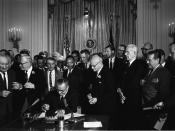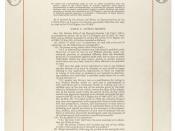Affirmative Action Kenneth Huttner ECO 325 Professor Krall April 24, 2002 Discrimination is a problem that has plagued our country for many years. In the past few decades the government has been attempting to correct the problem through anti discrimination legislation. Some of the biggest programs have been through affirmative action. There is a general consensus that there are problems in our society with discrimination in many areas. But the questions we must ask are: Is affirmative action a just way to solve the problem of discrimination? Is affirmative action constitutional or is it reverse discrimination? And how do we go about solving the problem of discrimination if not through affirmative action? President Kennedy first introduced affirmative action in 1961 although he did not really possess the power to do much about it without the support of Congress. Affirmative action was expanded into the arena of government contracts. Kennedy made a declaration that said that upon accepting a government contract the contractor must pledge not to discriminate against any applicants or employees on the basis of race, creed, color, or national origin(Elliot and Ewoh, p212).
Although the contractors made this pledge there was not much enforcement of it.
In 1964 congress took steps battle discrimination in the workplace. Title VII of the 1964 Civil Rights Act said that no person could be discriminated against on the basis of race, color, or national origin when it came to publicly funded programs. This was expanded in 1965 when president Johnson declared that the government would provide equal opportunity employment. Then in 1967 this was again expanded to make it illegal to discriminate on the basis of gender as well as race(Elliot and Ewoh, p213).
In 1970 the Department of Labor ordered that all contractors with government contracts, fifty or more employees, and...


